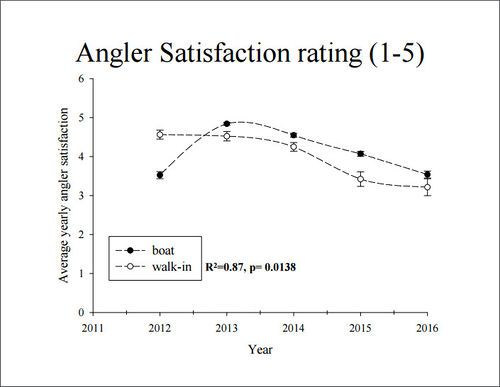Difference between revisions of "FISHERY"
Cellsworth (Talk | contribs) |
Cellsworth (Talk | contribs) |
||
| Line 174: | Line 174: | ||
---- | ---- | ||
| + | |||
| + | |- | ||
| + | ! <h2 style="margin:0; background:#cedff2; font-size:120%; font-weight:bold; border:1px solid #a3b0bf; text-align:left; color:#000; padding:0.2em 0.4em;"> [[Media:Appendix D Final Chub Triggers 2017.pdf| LTEMP BiOp Triggers for Trout Removals at the LCR (LTEMP BA Appendix D)]] </h2> | ||
| + | |- | ||
| + | |style="color:#000;"| | ||
| + | |||
| + | === '''Tier 1 Trigger – Early Intervention Through Conservation Actions:''' === | ||
| + | |||
| + | *1a. If the combined point estimate for adult HBC (adults defined ≥200 mm) in the Colorado River mainstem LCR aggregation; RM 57-65.9) and Little Colorado River (LCR) falls below 9,000 as estimated by the currently accepted HBC population model (e.g., ASMR, multi-state). | ||
| + | |||
| + | -OR- | ||
| + | |||
| + | *1b. If recruitment of sub-adult HBC (150-199mm) does not equal or exceed estimated adult mortality such that: | ||
| + | |||
| + | # Sub-adult abundance falls below a three-year running average of 1,250 fish in the spring LCR population estimates, or | ||
| + | # Sub-adult abundance falls below a three-year running average of 810 fish in the mainstem Juvenile Chub Monitoring reach (JCM annual fall population estimate; RM 63.45-65.2). | ||
| + | |||
| + | Tier 1 Trigger Response: | ||
| + | *Tier 1 conservation actions listed below will be immediately implemented either in the LCR or in the adjacent mainstem. Conservation actions will focus on increasing growth, survival and distribution of HBC in the LCR & LCR mainstem aggregation area. | ||
| + | |||
| + | === '''Tier 2 Trigger - Reduce threat using mechanical removal if conservation actions in Tier 1 are insufficient to arrest a population decline:''' === | ||
| + | Mechanical removal of nonnative aquatic predator will ensue: | ||
| + | *If the point abundance estimate of adult HBC decline to <7,000, as estimated by the currently accepted HBC population model. | ||
| + | |||
| + | Mechanical removal will terminate if: | ||
| + | *Predator index (described below) is depleted to less than 60 RBT/km for at least two years in the JCM reach and immigration rate is low (the long term feasibility of using immigration rates as a metric still needs to be assessed), | ||
| + | -OR- | ||
| + | *Adult HBC population estimates exceed 7,500 and recruitment of sub-adult chub exceed adult mortality for at least two years. | ||
| + | |||
| + | [[File:PredatorIndexTable.jpg|center|500px]] | ||
| + | |||
| + | If immigration rate of predators into JCM reach is high, mechanical removal may need to continue. These triggers are intended to be adaptive based on ongoing and future research (e.g., Lees Ferry recruitment and emigration dynamics, effects of trout suppression flows, effects of Paria River turbidity inputs on predator survival and immigration rates, interactions between humpback chub and rainbow trout, other predation studies). | ||
|- | |- | ||
Revision as of 13:31, 21 March 2017
|
|
The Lees Ferry Rainbow Trout FisheryIn 1964, the Lees Ferry tailrace on the Colorado River was given birth by the completion of Glen Canyon Dam, which impounded Lake Powell. Subsequent water releases from the bottom of Lake Powell changed the once highly turbid, warm waters of the Colorado River into a constant cold (46-50°F), clear flowing river. Shortly after completion of the dam, the Arizona Game and Fish Department stocked rainbow trout (Oncorhynchus mykiss) in the 15-mile Lees Ferry reach and, in 1981, began to manage this section of river as a Blue Ribbon rainbow trout fishery. The trout began to flourish in the Lees Ferry reach from 1970-1985 when catches of rainbow trout above 10-pounds were not uncommon, and angler pressure was relatively low. In 1991, however, the Bureau of Reclamation implemented the Record of Decision flow regime, which consisted of higher minimum and more stable flows and allowed for increased trout reproduction and survival. Under these conditions, a huge population of trout developed causing individual fish growth rates to decline. Quite simply, there was a large number of fish competing for limited space and food items, resulting in a fishery where trout less than 14-in were dominant. In 2000, the Arizona Game and Fish Department began a long-term monitoring program sponsored by Grand Canyon Monitoring and Research Center to determine the effects of Glen Canyon Dam operation on the trout fishery at Lees Ferry and to make recommendations for improving this fishery. Since 2000, our data collection has shown an increase in the general health of all trout age classes (especially since 2002). This increase in fish health is usually associated with an increase in growth rates. There has been a marked increase in catch rates of young-of-the-year fish in recent years. With successful spawning and recruitment continuing to occur, fishing conditions in Lees Ferry are improving. [1] Desired Future Condition for the Lees Ferry Trout FisheryA high quality trout fishery in GCNRA, as further described in the Recreation DFC that does not adversely affect the native aquatic community in GCNP. |
| File:RainbowTrout1.jpg* Rainbow Trout |
File:BrownTrout1.jpg* Brown Trout |
|---|
|
Quick FactsVisitor Use and Experience
HISTORY
Additional Links
|















